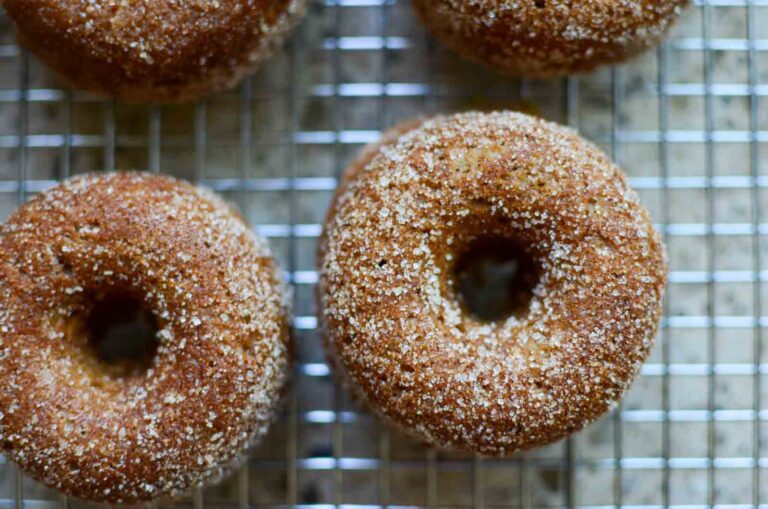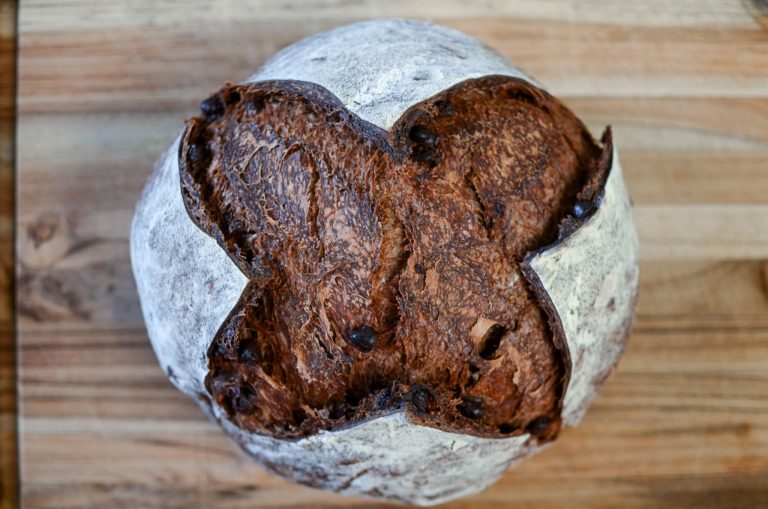Easy Sourdough Blueberry Lemon Focaccia Bread
This post may contain affiliate links. As an Amazon Associate, I may receive a small commission, at no cost to you, if you make a purchase. Please read our disclosure policy.
This easy sourdough blueberry lemon focaccia bread has a bright, lemon flavor and is loaded with juicy, sweet blueberries. Baked using active sourdough starter and is full of lemon zest, lemon juice, plenty of fresh blueberries for a fresh, yummy taste and finished with a sweet lemon glaze. It’s the perfect way to enjoy juicy blueberries during blueberry season.

It’s that time of year when the blueberries are starting to ripen and I’m gearing up for all things blueberry! From enjoying a bowl of blueberries for a simple afternoon snack to sourdough blueberry muffins for breakfast, my family always looks forward to this time of year.
Why You’ll Love This Blueberry Lemon Sourdough Bread
- Sourdough – Capturing wild yeast gives this lemon blueberry sourdough bread its rise in addition to the benefits of long fermentation. This helps break down the gluten and phytic acid in the flour, making it easier to digest.
- Basic kitchen equipment – No need for a Dutch oven, just a bowl to mix the dough and a baking pan to bake in.
- Easy – While baking with sourdough takes a bit of time and patience, the process is relatively simple. Baking focaccia bread is a great way to learn baking with sourdough without the added step of shaping a freeform loaf.
- Seasonal eating – A sweet treat that’s full of blueberry goodness to enjoy during the height of the blueberry season.
Equipment For Easy Sourdough Blueberry Lemon Focaccia Bread
- Baking pan
- Large bowl
- Danish dough whisk
- Citrus juicer
- Citrus zester
- Parchment paper
- Kitchen scale
Easy Sourdough Blueberry Lemon Focaccia Bread Ingredients
- Sourdough starter – You will need an active sourdough starter for this lemon blueberry focaccia loaf. This means the sourdough starter has been fed recently, risen to its peak, and is full of bubbles and activity.
- Water – Use warm water in the cooler months to help the dough rise.
- Flour – Since bread flour has a higher protein content than all-purpose flour, it’s able to develop more gluten, leading to a stretchy and elastic dough. The final bake results in a loaf with plenty of air pockets.
- Sugar – Just a touch to enhance the flavor of the focaccia and give the crust a golden brown color.
- Salt – Flavors the bread and also helps the bread rise.
- Lemon juice and zest – Fresh lemons provide a bright, tart flavor. I recommend using organic lemons since you’ll be zesting the rind.
- Blueberries – Use fresh blueberries when in season. If using frozen blueberries, allow them to thaw and drain the moisture they release before adding to the dough.
- Butter – Use melted unsalted butter.
- Powdered sugar – Sweetens the lemony glaze.
- Olive oil – For greasing the pan only! Don’t add to the dough.
How to Make Easy Sourdough Lemon Blueberry Focaccia Bread
4-6 hours before you are ready to mix the dough, feed the sourdough starter a ratio of 1:1:1, or equal parts flour, water, and starter, and allow it to come to its peak. The exact timing of when it comes to its peak will vary depending on the temperature of your kitchen and the strength of your starter.
Mix the Dough
Add 100 g (1/2 cup) active sourdough starter, 500 g (4 cups) flour, 400 g (1 2/3 cups) water, 10 g (2 tsp) salt, and 50 g (1/4 cup) sugar to a large bowl and combine using a Danish dough whisk until fully mixed. Cover the bowl and let the dough rest at room temperature for 30 minutes to let the flour hydrate.
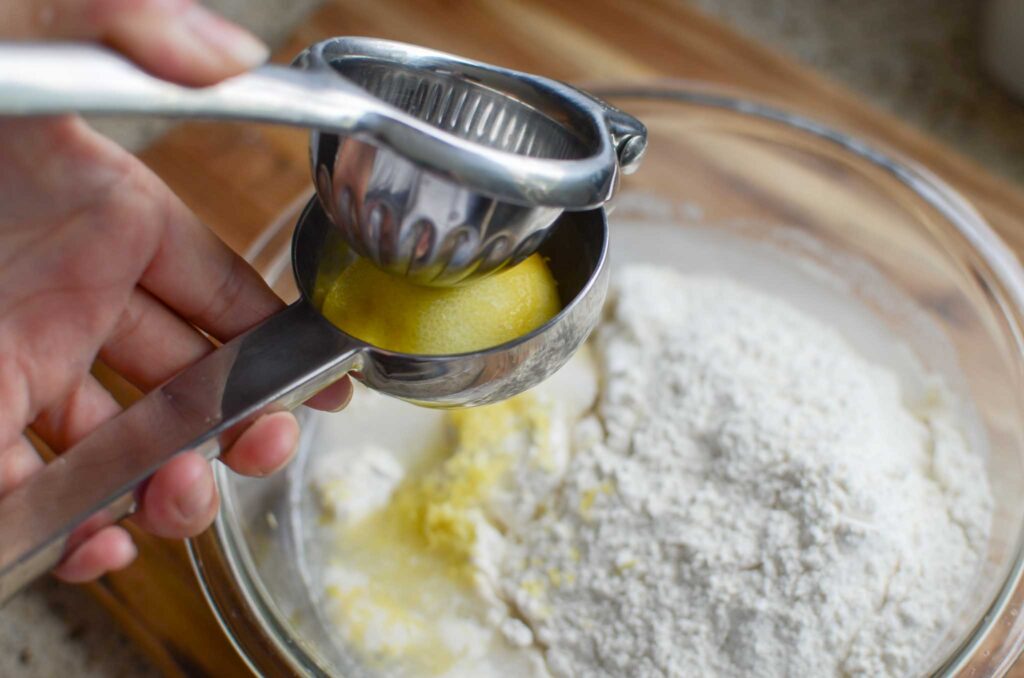

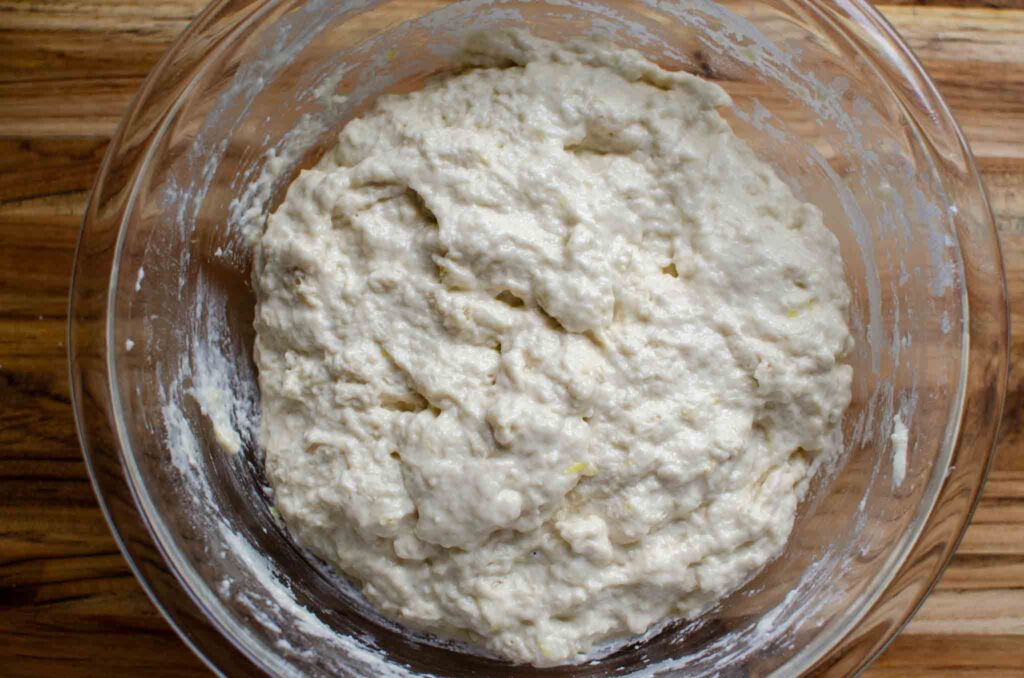
Do a set of stretches and folds. Grab the side of the dough along the side of the bowl, lift it straight up, and then fold it onto itself into the middle of the dough. Rotate the bowl a quarter of a turn and repeat along the sides of the bowl for a total of 12-15 stretches. Cover the bowl and allow to rest for 30 minutes. This completes one set of stretch and folds.
Continue stretching and folding for a total of 3 sets of stretch and folds. From the first set of stretch and folds to the last, the dough will transform from a sticky dough that covers your hands to an elastic dough with minimal sticking.
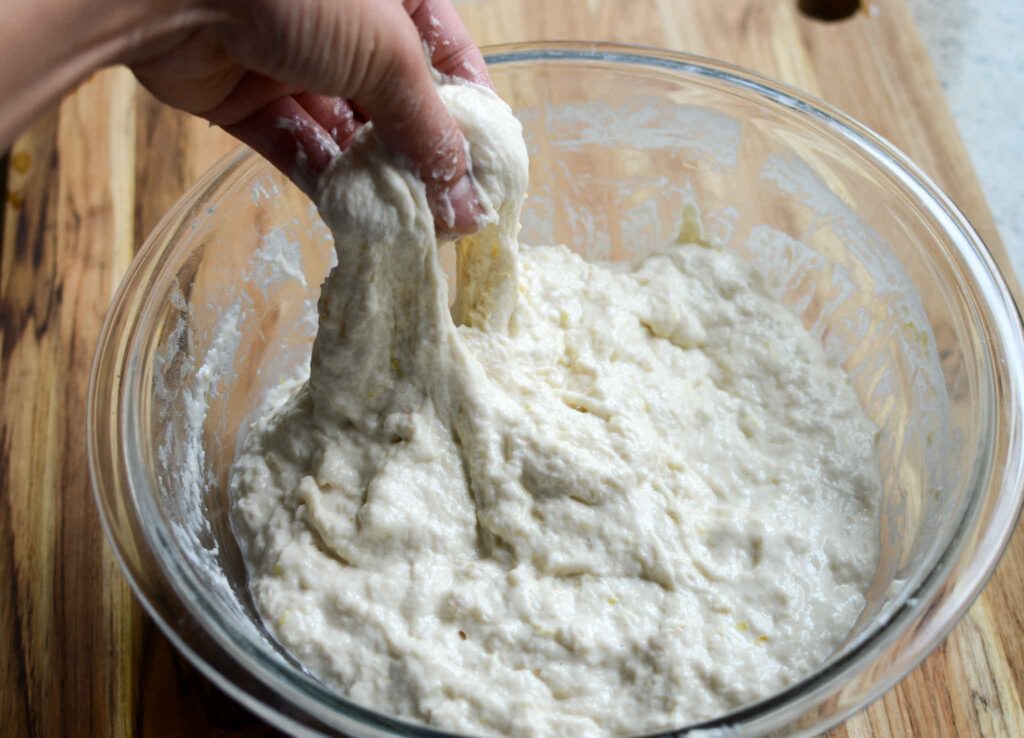
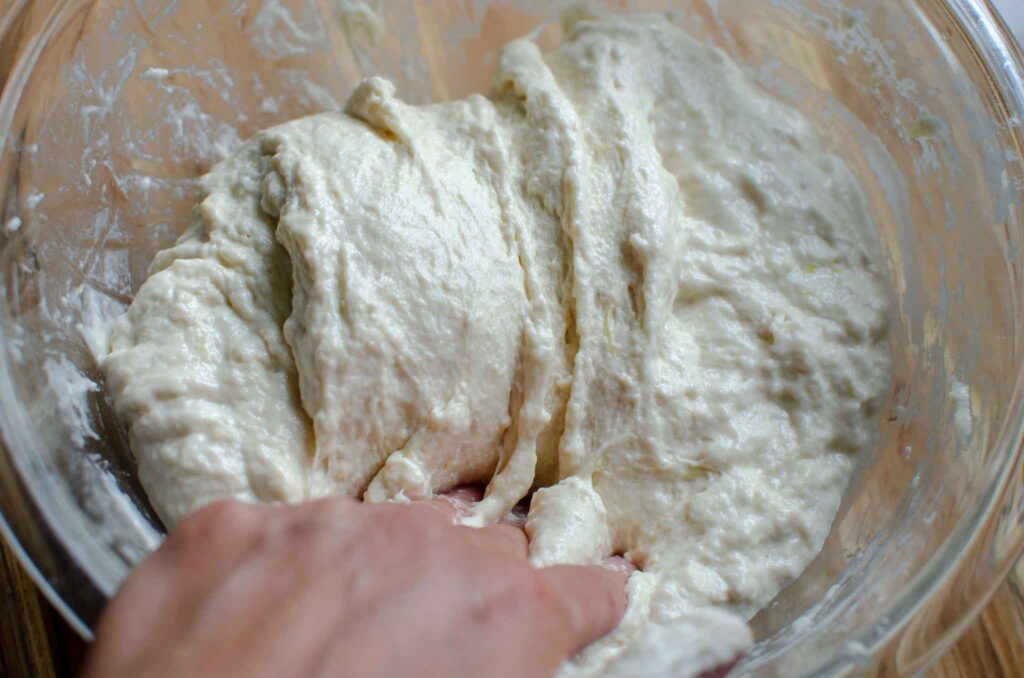
Bulk Fermentation or First Rise
After the last set of stretch and folds, cover the bowl and let rest in a warm spot in the kitchen to bulk ferment, roughly 3-6 hours.
Knowing when the bulk ferment is done is one of the most challenging parts of working with sourdough. There are a few factors, like kitchen temperature and how well the dough has been worked, that can affect how long it takes, making time an ineffective metric to use alone.
Looking for a few indicators will help determine when the dough is done bulk fermenting. First, the top of the dough will have plenty of air bubbles, indicating that the dough is strong enough to trap the air. Second, the dough will be slightly domed at the edge of the bowl, showing that it’s risen. And lastly, if you tug the edge of the dough, it will be elastic and stretchy.

The dough will have a second rise, so if you aren’t sure, err on the side of moving to the next step sooner rather than later. Given too much time to bulk ferment will result in the dough losing it’s gluten structure and turning into a puddle of goo.
Cold Ferment
Cover the bowl and refrigerate overnight. Time in the fridge allows the yeast activity to slow down, giving the flavors a chance to develop more depth and complexity.
Shape and Second Rise
The next morning, prepare the pan by placing a piece of parchment paper into the bottom of the baking pan and drizzle 30 g (2 tbsp) olive oil evenly over the parchment paper.
Using a bowl scraper, turn the dough out into the pan. Rub a bit of olive oil onto your fingers and stretch and pull the dough to fit the pan.
Cover the pan with a tea towel or a bit of plastic wrap and place in a warm place for 4-5 hours. During this time, the dough will have visibly risen with plenty of air bubbles showing beneath the surface.
The exact time will largely depend on the temperature of your kitchen. If your kitchen is cold, place the pan in the oven with the light on to create a warmer environment. Be sure to remove it before preheating the oven.
Dimple and Bake
Preheat oven to 400 degrees.
Sprinkle blueberries over the top of the dough. Pour melted butter evenly over the top of the dough.
Press your fingertips into the dough, creating dimples across the entire pan.
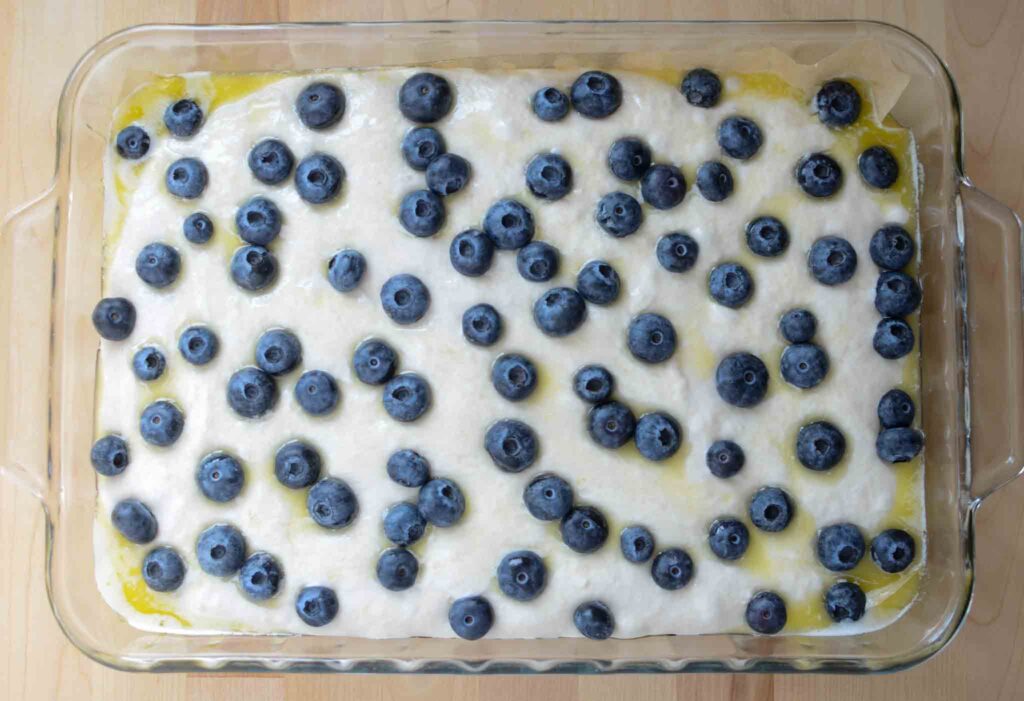
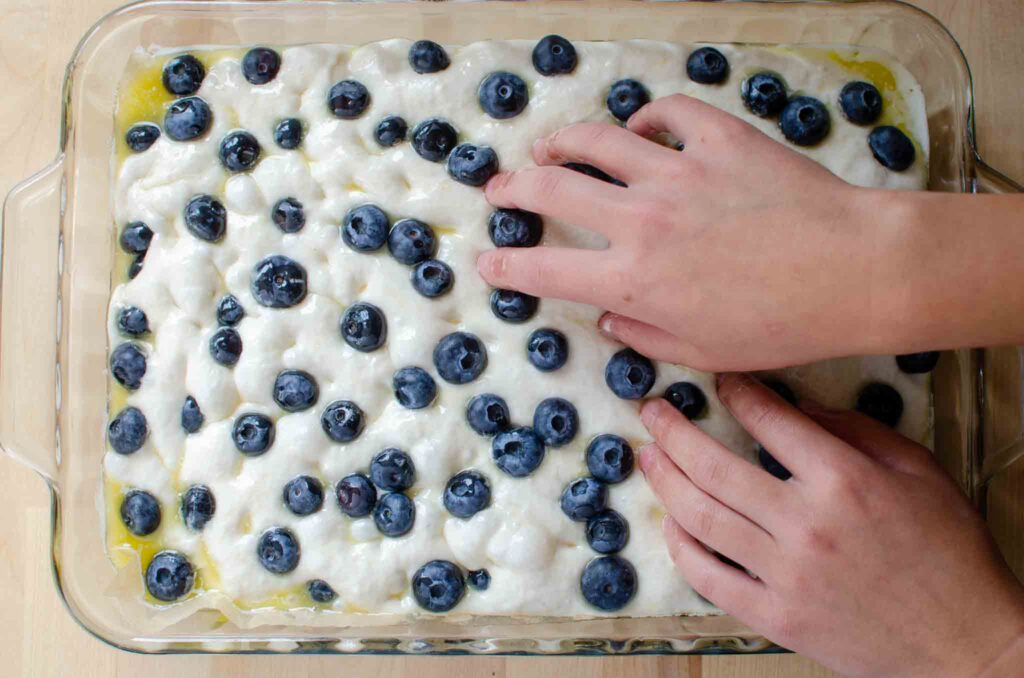

Place into the oven and bake for 30-40 minutes. The focaccia is done when the top is a light golden brown and the internal temperature reads 200 degrees.
Lemon Glaze
While the bread is baking, prepare the glaze. Juice a lemon and add to a small bowl. In a separate small bowl, whisk 2-3 tablespoons of lemon juice and 130 g (1 cup) powdered sugar until smooth. Use more lemon juice, if needed, to create a smooth, pourable lemon glaze.
Remove the focaccia from the pan and onto a wire rack to cool, discarding the parchment paper.
Allow the bread to cool to room temperature before drizzling the glaze over the top of the sourdough blueberry lemon focaccia bread.
Store
Sourdough blueberry lemon focaccia bread is best the same day you bake it. If you do have leftovers, store them in an airtight container at room temperature and enjoy them within a day or two.
Sample Schedule
Day 1
- 8:00 am – Feed starter and allow to come to peak
- 1:30 pm – Combine dough
- 2:00 pm – First set of stretch and folds
- 2:30 pm – Second set of stretch and folds
- 3:00 pm – Third set of stretch and folds
- 3:00 – 9:00 pm – Bulk ferment at room temperature
- 9:00 pm – 7:00 am – Cold ferment
Day 2
- 7:00 am – 1:00 pm – Shape in pan and second rise
- 1:00 pm – Preheat oven, add blueberries, and dimple dough
- 1:15 pm – Bake bread and make glaze
- 2:30 pm – Glaze bread


Easy Sourdough Blueberry Lemon Focaccia Bread
Equipment
- 9 X 13 baking dish
- large bowl
- Danish dough whisk
- citrus juicer
- citrus zester
- parchment paper
- kitchen scale
Ingredients
Dough Ingredients
- 100 g active sourdough starter ⅓ cup
- 400 g warm water 1⅔ cups
- 50 g granulated sugar ¼ cup
- 10 g salt
- 500 g bread flour 4 cups
- 3 tbsp lemon juice 1 large lemon
- 3 tsp lemon zest 1 large lemon
- 30 g olive oil Don't add to the dough! This is for adding to the pan.
Topping
- 1 cup fresh blueberries
- 62 g unsalted butter, melted ¼ cup
Lemon Glaze
- 2-3 tbsp lemon juice
- 130 g powdered sugar 1 cup
Instructions
- 4-6 hours before you are ready to mix the dough, feed the sourdough starter a ratio of 1:1:1, or equal parts flour, water, and starter, and allow it to come to its peak. The exact timing of when it comes to its peak will vary depending on the temperature of your kitchen and the strength of your starter.
Mix the Dough
- Add 100 g (1/2 cup) active sourdough starter, 500 g (4 cups) flour, 400 g (1 2/3 cups) water, 10 g (2 tsp) salt, and 50 g (1/4 cup) sugar to a large bowl and combine using a Danish dough whisk until fully mixed. Cover the bowl and let the dough rest at room temperature for 30 minutes to let the flour hydrate.
- Do a set of stretches and folds. Grab the side of the dough along the side of the bowl, lift it straight up, and then fold it onto itself into the middle of the dough. Rotate the bowl a quarter of a turn and repeat along the sides of the bowl for a total of 12-15 stretches. Cover the bowl and allow to rest for 30 minutes. This completes one set of stretch and folds.
- Continue stretching and folding for a total of 3 sets of stretch and folds. From the first set of stretch and folds to the last, the dough will transform from a sticky dough that covers your hands to an elastic dough with minimal sticking.
Bulk Fermentation or First Rise
- After the last set of stretch and folds, cover the bowl and let rest in a warm spot in the kitchen to bulk ferment, roughly 3-6 hours.(Read text above for more information on what to look for when the dough is done bulk fermenting)
Cold Ferment
- Cover the bowl and refrigerate overnight.
Shape and Second Rise
- The next morning, prepare the pan by placing a piece of parchment paper into the bottom of the baking pan and drizzle 30 g (2 tbsp) olive oil evenly over the parchment paper.
- Using a bowl scraper, turn the dough out into the pan. Rub a bit of olive oil onto your fingers and stretch and pull the dough to fit the pan.
- Cover the pan with a tea towel or a bit of plastic wrap and place in a warm place for 4-5 hours. During this time, the dough will have visibly risen with plenty of air bubbles showing beneath the surface.The exact time will largely depend on the temperature of your kitchen. If your kitchen is cool, place the pan in the oven with the light on to create a warmer environment. Be sure to remove it before preheating the oven.
Dimple and Bake
- Preheat oven to 400 degrees.
- Sprinkle blueberries over the top of the dough.
- Pour melted butter evenly over the top of the dough.
- Press your fingertips into the dough, creating dimples across the entire pan.
- Place into the oven and bake for 30-40 minutes. The focaccia is done when the top is a light golden brown and the internal temperature reads 200 degrees.
Lemon Glaze
- While the bread is baking, prepare the glaze. Juice a lemon and add to a small bowl. In a separate small bowl, whisk 2-3 tablespoons lemon juice and 130 g (1 cup) powdered sugar until smooth. Use more lemon juice, if needed, to create a smooth, pourable lemon glaze.
- Remove the focaccia from the pan and place onto a wire rack to cool, discarding the parchment paper.
- Allow the bread to cool to room temperature before drizzling the glaze over the top of the sourdough blueberry lemon focaccia bread.
Store
- Sourdough blueberry lemon focaccia bread is best the same day you bake it. If you do have leftovers, store them in an airtight container at room temperature and enjoy them within a day or two.





